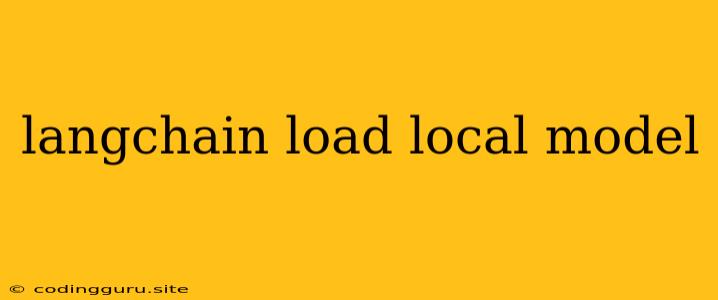Leveraging the Power of Local Models with LangChain: A Comprehensive Guide
In the realm of large language models (LLMs) and artificial intelligence (AI), LangChain emerges as a powerful tool for building sophisticated applications. While cloud-based models like OpenAI's GPT-3 offer impressive capabilities, scenarios often arise where utilizing local models becomes crucial. This might be due to data privacy concerns, offline access requirements, or the need for tailored model fine-tuning.
This guide delves into the intricacies of loading local models within LangChain, empowering you to seamlessly integrate these models into your projects.
Understanding the Need for Local Models
Before diving into the practical aspects, let's clarify why loading local models is a valuable approach:
- Data Privacy: For applications handling sensitive data, storing and processing information on local servers ensures data security and compliance with regulations.
- Offline Access: In situations where internet connectivity is limited or unreliable, local models enable functionality without external reliance.
- Customization and Fine-tuning: Local models allow you to tailor models to specific domains or tasks, enhancing accuracy and relevance for specific use cases.
LangChain: Your Toolkit for Model Integration
LangChain provides a versatile framework for orchestrating diverse AI components, including LLMs. It offers a streamlined approach for loading local models, enabling you to harness their capabilities within your applications.
Steps to Load a Local Model with LangChain
-
Model Selection: Choose the appropriate local model for your needs. Popular options include:
- Hugging Face Models: Access a wide range of pre-trained models from the Hugging Face Model Hub.
- Local PyTorch Models: If you've trained your own model using PyTorch, you can readily load it locally.
- TensorFlow Saved Models: Similar to PyTorch, TensorFlow allows you to save and load trained models locally.
-
Model Loading with LangChain: LangChain offers various methods for loading local models:
- Hugging Face Integration:
from langchain.llms import HuggingFaceHub from transformers import AutoTokenizer, AutoModelForSequenceClassification tokenizer = AutoTokenizer.from_pretrained("distilbert-base-uncased-finetuned-mrpc") model = AutoModelForSequenceClassification.from_pretrained("distilbert-base-uncased-finetuned-mrpc") llm = HuggingFaceHub(repo_id="distilbert-base-uncased-finetuned-mrpc", model_kwargs={"tokenizer": tokenizer, "model": model}) print(llm("This is a test sentence.")) - Local PyTorch Models:
from langchain.llms import PyTorchLLM from transformers import AutoModelForSequenceClassification model = AutoModelForSequenceClassification.from_pretrained("distilbert-base-uncased-finetuned-mrpc") llm = PyTorchLLM(model=model) print(llm("This is a test sentence.")) - TensorFlow Saved Models:
from langchain.llms import TensorflowLLM from transformers import AutoTokenizer, AutoModelForSequenceClassification tokenizer = AutoTokenizer.from_pretrained("distilbert-base-uncased-finetuned-mrpc") model = AutoModelForSequenceClassification.from_pretrained("distilbert-base-uncased-finetuned-mrpc") llm = TensorflowLLM(model=model) print(llm("This is a test sentence."))
- Hugging Face Integration:
-
Model Usage: Once loaded, you can interact with the local model using LangChain's API.
Practical Example: Sentiment Analysis with a Local Model
Imagine you want to build a sentiment analysis application using a pre-trained BERT model. Here's how to load it locally and use it within your code:
from langchain.llms import HuggingFaceHub
from transformers import AutoTokenizer, AutoModelForSequenceClassification
# Load the model and tokenizer
tokenizer = AutoTokenizer.from_pretrained("bert-base-uncased-finetuned-mrpc")
model = AutoModelForSequenceClassification.from_pretrained("bert-base-uncased-finetuned-mrpc")
# Create the LangChain LLM
llm = HuggingFaceHub(repo_id="bert-base-uncased-finetuned-mrpc",
model_kwargs={"tokenizer": tokenizer, "model": model})
# Analyze the sentiment of a sentence
sentence = "This movie was absolutely amazing!"
output = llm(sentence)
print(output) # Output: Positive
Conclusion
Loading local models with LangChain empowers developers to leverage the power of AI models while addressing specific requirements such as data privacy, offline access, and model customization. LangChain's flexibility and ease of use make it an invaluable tool for integrating local models into various applications. By following the steps outlined in this guide, you can seamlessly integrate local models into your projects, unlocking new possibilities and enhancing the functionality of your applications.
